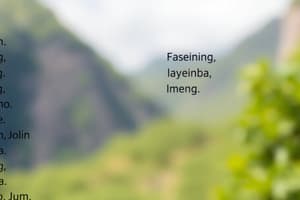Podcast
Questions and Answers
Which characteristic best describes a 'tambalan' noun?
Which characteristic best describes a 'tambalan' noun?
- It is formed by repeating a word or part of a word.
- It is a single word that has multiple meanings.
- It is a word that changes meaning based on context.
- It is formed by combining two different words to create a new meaning. (correct)
What is the primary effect of reduplication in 'inuulit' nouns?
What is the primary effect of reduplication in 'inuulit' nouns?
- To create a completely new meaning unrelated to the root word.
- To emphasize repetition, intensity, or plurality. (correct)
- To indicate a change in tense of the verb.
- To indicate a past action.
Which of the following is an example of a 'tambalan' noun?
Which of the following is an example of a 'tambalan' noun?
- Anak-pawis (correct)
- Takbo-takbo
- Salin-salin
- Araw-araw
What does the word 'puno-puno' mean?
What does the word 'puno-puno' mean?
Which term describes a noun formed by the combination of 'araw' and 'gabi'?
Which term describes a noun formed by the combination of 'araw' and 'gabi'?
Flashcards
Inuulit (Reduplicated Nouns)
Inuulit (Reduplicated Nouns)
Nouns formed by repeating a word or part of a word, emphasizing repetition, intensity, or plurality. Examples: Araw-araw (Everyday), Bahay-bahay (House to house).
Tambalan (Compound Nouns)
Tambalan (Compound Nouns)
Nouns formed by combining two different words to create a new meaning. The combination makes a new concept or idea that's different from the individual words. Examples: Araw-gabi (Day and night), Bahaghari (Rainbow).
Araw-gabi (Day and night)
Araw-gabi (Day and night)
Indicates a continuous period covering both day and night.
Bahaghari (Rainbow)
Bahaghari (Rainbow)
Signup and view all the flashcards
Pusong-bato (Heart of stone)
Pusong-bato (Heart of stone)
Signup and view all the flashcards
Study Notes
Noun Structure: Inuulit and Tambalan
-
Inuulit (Reduplicated): Nouns formed by repeating a whole word or part of a word.
- In English, this emphasizes repetition, intensity, or plurality.
- Examples:
- Araw-araw (Everyday): Something that happens daily
- Bahay-bahay (House to house): Visiting several houses
- Laro-laro (Playing repeatedly): Engaging in play multiple times
- Sulat-sulat (Writing repeatedly): Writing continuously
- Puno-puno (Full of trees): A place filled with many trees
- Salin-salin (Passed from one to another): Transmission from one to another
- Basa-basa (Reading repeatedly): Repeated reading
- Takbo-takbo (Running repeatedly): Repeated running
- Kain-kain (Eating repeatedly): Repeated eating
-
Tambalan (Compound): Nouns formed by combining two different words.
- The combination creates a novel meaning not found in the individual words.
- Examples:
- Araw-gabi (Day and night): Continuity encompassing both day and night
- Bahaghari (Rainbow): A natural phenomenon with rain and sunlight
- Salin-lahi (Generation): Transfer or succession of generations
- Pusong-bato (Heart of stone): Someone emotionally hardened
- Isdang-bato (Stonefish): A fish resembling a stone
- Pamatay-sunog (Fire extinguisher): Device for extinguishing fires
- Anak-pawis (Working class): People who work
- Dalagang-bukid (Farm girl): A rural girl
- Bukas-loob (Open-hearted): Generous and kind
- Bukang-liwayway (Dawn): Beginning of day
Studying That Suits You
Use AI to generate personalized quizzes and flashcards to suit your learning preferences.




